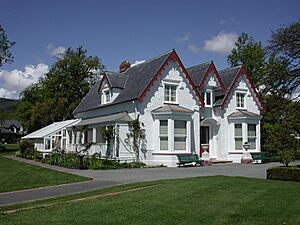Monaco, New Zealand facts for kids
Quick facts for kids
Monaco
|
|
|---|---|
|
Suburb
|
|

Broadgreen House
|
|
| Country | New Zealand |
| Region | Nelson |
| Ward |
|
| Electorates |
|
| Area | |
| • Total | 1.14 km2 (0.44 sq mi) |
| Population
(June 2023)
|
|
| • Total | 2,490 |
| • Density | 2,184/km2 (5,660/sq mi) |
| Time zone | UTC+12 (NZST) |
| • Summer (DST) | UTC+13 (NZDT) |
| Postcode |
7010
|
| Area code(s) | 03 |
Monaco is a small area in Nelson, New Zealand. It is located west of Stoke town centre. Monaco sits on a narrow piece of land that stretches into Tasman Bay / Te Tai-o-Aorere. It is very close to Nelson Airport.
The area, officially called Broadgreen-Monaco, covers about 1.14 square kilometers. This includes the narrow piece of land it sits on.
Contents
Monaco's Population History
Monaco has seen its population change over the years. In 1996, about 2,160 people lived there. By 2001, the number grew to 2,190. It reached 2,298 in 2006 and stayed the same in 2013. The population then increased to 2,376 people in 2018.
Who Lives in Broadgreen-Monaco?
The Broadgreen-Monaco area had an estimated population of 2,490 as of June 2023, . This means there are about 2184 people living in each square kilometer.
| Historical population | ||
|---|---|---|
| Year | Pop. | ±% p.a. |
| 2006 | 2,298 | — |
| 2013 | 2,298 | +0.00% |
| 2018 | 2,376 | +0.67% |
In 2018, the population of Broadgreen-Monaco was 2,376. This was 78 more people than in 2013. There were 927 homes in the area. There were 1,122 males and 1,254 females.
The average age of people in Monaco was 44.2 years. About 18.3% of the people were under 15 years old. Also, 20.6% were 65 years or older.
Most people in Monaco (89.9%) are of European background. About 10.6% are Māori. Other groups include Pasifika (2.7%) and Asian (3.7%). Some people identify with more than one ethnic group.
About 17.9% of the people in Monaco were born outside New Zealand.
When asked about religion, 53.4% said they had no religion. About 35.1% were Christian. A smaller number followed Māori religious beliefs (0.8%), Hindu (0.3%), or Buddhist (0.4%) faiths.
Many adults in Monaco have good education. About 13.6% of people aged 15 or older had a university degree. The average income was $27,500. About 10.8% of people earned over $70,000. Most adults (45.6%) worked full-time.
What Jobs Do People Do in Monaco?
In 2018, people in Monaco worked in many different jobs.
- About 12.7% worked in making things (manufacturing).
- 9.2% worked in building (construction).
- 6.2% worked in hotels and restaurants (hospitality).
- 6.2% worked in moving goods or people (transport).
- 9.2% worked in schools (education).
- 12.2% worked in hospitals or clinics (healthcare).
Getting Around Monaco
In 2018, most people in Monaco drove to work.
- 71.6% drove a car by themselves.
- 3.8% rode in a car with someone else.
- 2.4% rode a bike.
- 2.4% walked or ran to work.
No one used public transport like buses or trains to get to work.
Learning in Monaco: Birchwood School
Monaco is home to Birchwood School. This is a public primary school for students in Year 1 to Year 6. It teaches both boys and girls. The school has 215 students as of February 2024.

